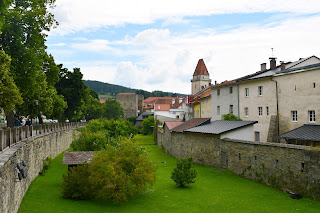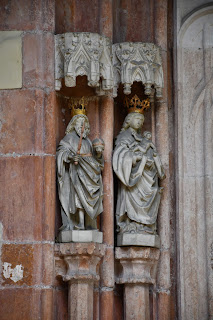A Four-Day Tour of Austria and Bavaria
Not long after my sister returned from her “studies” in Chicago, we embarked on our long-planned trip to our southern neighbours. Setting off on Monday, we made good use of two Czech holidays (Saints Cyril and Methodius day on the 5th and the Immolation of Jan Hus on the 6th) to enjoy our stay in Austria during the work week.
Our first stop was Freistadt, a picturesque, pastel coloured
town just south of the Czech border. The Bohemian gate at the northern end of
the city reflects this historical proximity and forms part of the town’s very
prominent medieval fortifications. These surround a pleasant baroque centre
with its fountain, church, and several fancily decorated townhouses. We
strongly appreciated the free parking right by Scheibling Tower.
Our next stop was Mauthausen concentration camp, which is situated in the deceptively idyllic countryside to the east of Linz. I think one of the most powerful testaments to the brutality of the camp is the underground exposition, where the names of the known victims are recorded in thick folders neatly arranged in alphabetical order. They are also written in tiny white letters across black slabs which occupy the larger part of the room.
After eating lunch, we visited Linz, Austria’s third biggest
city. We left the car in a parking garage essentially right under the main
square; it is amazing how well the system of public parking (though admittedly
not free in this case) works throughout Austria. Linz’s prettiest tourist
attractions include the Trinity Column, the Old Cathedral, the Carmelite
Convent, and Saint Mary’s Cathedral, all of which (with the exception of the
last), are conveniently located along the main square and the adjacent Landstraße.
At one point, I lost my sister inside Saint Mary’s
Cathedral, as she decided to move places and fall asleep while I was taking
pictures. In my ensuing panic, I could not for the life for me remember how to
say “kidnapped” in German.
Despite having guzzled down a lot of ice cream that day, we
ate a hearty dinner in Salzburg, where we spent the following two nights. We
stayed just outside the city centre at Schloss Leopoldskron, a palace converted
into a hotel and the locale where much of Sound of Music was filmed. The former
palace stands atop the banks of a small lake, while offering views of
Hohensalzburg Castle in the other direction.
The view over the lake at Leopoldskron
More of the same
More of the same
Hohensalzburg Castle
The same
More of the same
Schloss Leopoldskron
Leopoldskron and Hohensalzburg
The same again
Leopoldskron again
One more view of Hohensalzburg
A view of the lake
The second day of our travels took us just beyond the
Austrian border to the town of Berchtesgaden, home to the Eagle’s Nest, Hitler’s
infamous Bavarian abode. Since it is not possible for private vehicles to drive
up to the house, we had to buy the rather expensive bus tickets there. We found
out why not long after, as we snaked our way up the winding, narrow,
vertiginous paths, which left me begging my sister to let us walk back down
(she did not).
The skies were sunny that day, offering beautiful views of
the surrounding mountains and valleys. Given the place’s history, it somehow
felt wrong to be enjoying the view, though one could understand why the
post-war government decided not to blast the house from the face of the rock. Nevertheless,
it felt perverse that while we heard a lot of Polish and very little Czech in
Mauthausen, Hitler’s mountain house had practically become a Czech tourist colony.
We returned to Salzburg a little before noon and spent the
rest of the day touring the city. We began at Kapuzinerberg (Capuchins
Mountain) in the north, which offers views of the entire city centre, and
continued west to the Mirabell Palace. Crossing the river, we entered the
centre, and walked east again, stopping by a number of churches and eventually
arriving at Stift Nonnberg. The convent, built on a hill that overlooks the
Kajetan Church and the southern end of the city, offers a complementary view to
the view from Kapuzinerberg on the other side of the river.
On the third day of our trip, we definitively left Austria for Bavaria. Passing by Munich, we visited Dachau concentration camp, where over forty thousand Jews, Poles, Roma, and others were killed. Today, many of the barracks are gone, with numerous foundations in neat lines commemorating the horrific size of the camp.
We then headed back to Munich, stopping by Nymphenburg
Palace on the way. For over three hundred years, the baroque complex served as
the main summer residence for the rulers of Bavaria. Not only is the main
structure itself massive (Wikipedia says its frontal width exceeds that of
Versailles), but the grounds are absurdly enormous. My sister rested on a bench
while I made a rather long trek around the main canal and back, which took
perhaps half an hour.
Before touring the city centre, we made another stop by the
Munich Propylaea, a Greek-style arch that leads to an entire city square
flanked by various towering museums. Since my sister wanted to watch some
important football match in the evening, we quickly toured the most important
sights in the centre before I dropped her off at the hotel and made a wider tour
by myself. Besides the widely-known Frauenkirche and Town Hall, several other
grandiose buildings like the Munich Residenz and the Upper Bavarian government
offices are well worth a visit.
Another view of the same
The same
Frauenkirche
The steeples of Frauenkirche
The so-called Monkey Tower
The government offices of Upper Bavaria
More of the same
The Saint Anna Church
The Bavarian Chancellery
The chancellery again
Diana Temple in Hofgarten
The same again
Theatine Church
Wittelsbach
The Munich District Court
A merman sculpture
Karlstor
Saint Michael's Church
Saint Peter's Church
Isar Gate
We didn’t have anything planned for our last day in Bavaria
besides returning home, but upon waking up we found the prospect of driving
straight back simply dreadful. We therefore decided to pay a quick visit to
Regensburg, a very medieval-looking UNESCO-listed city that sits atop Roman
foundations. Regensburg’s historic centre is quite compact, though its most
photogenic angle is from across the 12th century Stone Bridge. Interestingly,
this well-preserved part of town is owed to Regensburg’s slow post-WWII
recovery, which impeded the destruction of buildings damaged by Allied bombing.
Since we were in the neighbourhood, it was not difficult to
persuade my sister to stop by the 19th century Walhalla memorial. This
thoroughly bizarre Greek-style temple of sorts is a hall of fame for the
luminaries of the (rather broadly defined) German-speaking world. It is strange
to think how this merging of classical forms with German nationalism would
culminate a hundred years later in the art and architecture of Hitler’s Third
Reich.
Our last stop of the day was Flossenbürg concentration camp,
which incidentally had a subcamp in Regensburg (as well as a number of other
cities, towns, and villages throughout the region). The camp, which was meant
to produce granite for Hitler’s megalomaniacal visions of a Nazified Berlin, is
in fact quite close to the Czech border and was running an exposition on Czech
inmates when we visited. The ruins of Flossenbürg Castle, which dominate the
area, were held as a symbol of resistance against the expansion of Slavic
peoples.





























































































































































































Comments
Post a Comment